Why do my feet hurt so much? The link between menopause and searing heel pain
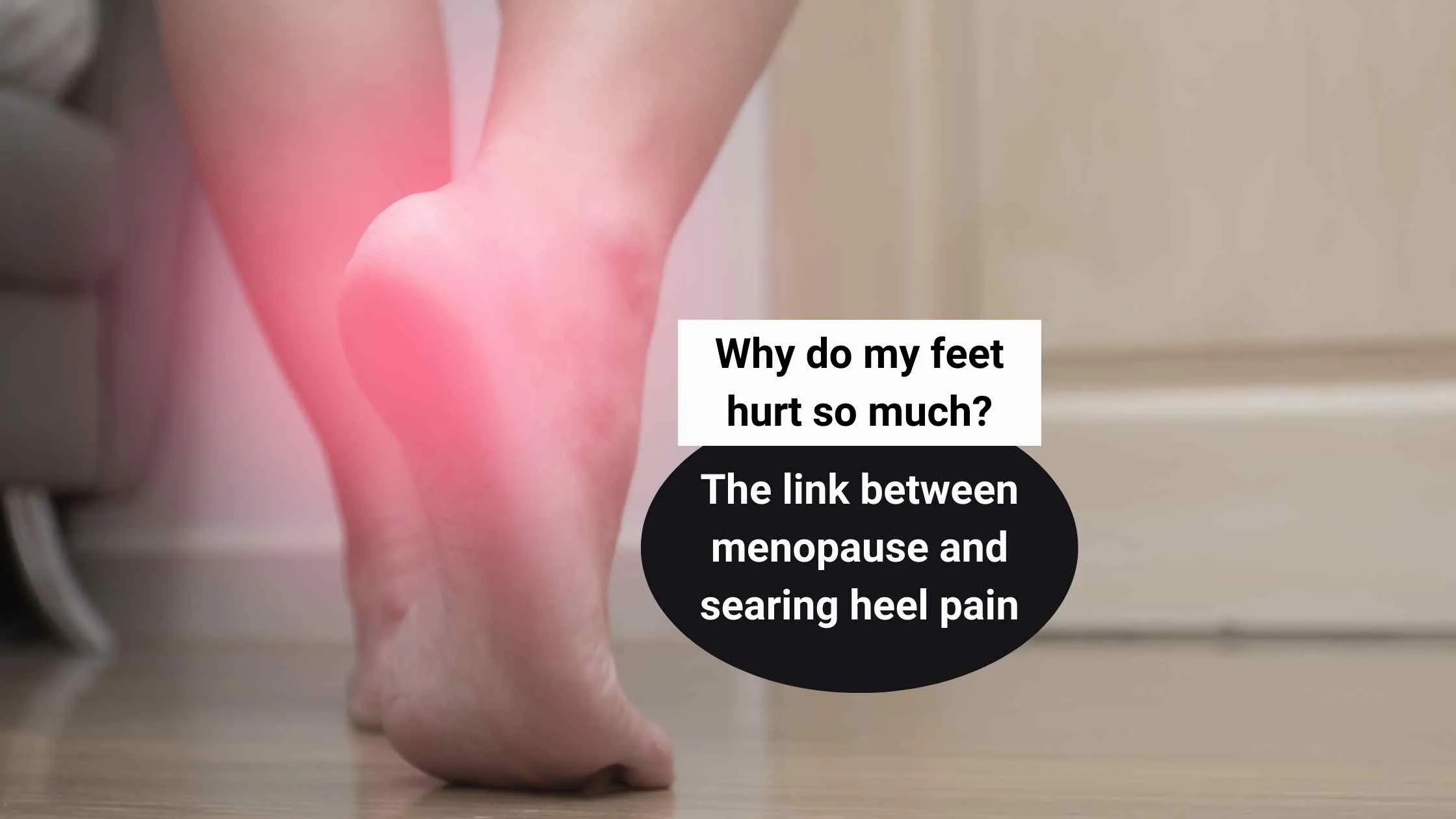
Why do my heels hurt so much?
That searing heel pain you’re experiencing, aka plantar fasciitis, could be a lesser known but common menopause nightmare.
In this post I’ll share my experience with plantar fasciitis in BOTH feet, how it impacted my exercise, and how I overcame the problem.
The menopause nightmares we’re more likely to know about
I was not really prepared for any of the menopause nightmares I experienced, but I had at least heard about the most common ones. Namely:
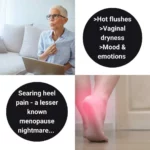
Hot flushes
That distressing feeling of heat rising through your body, making you sweat and feel desperate for fresh air and a cool breeze or something with which to fan yourself.
Vaginal dryness
I also knew that the decrease of oestrogen that occurs during perimenopause can cause the vaginal tissues to become dry, leaving them irritated and/or itchy and less lubricated during sex.
Mood & emotions
Another menopause symptom I had vaguely heard about before experiencing it for myself is the rollercoaster of emotions and accompanying changes in mood.
I also remember my poor mum being frazzled and fluctuating throughout her perimenopause years, putting up with the whole ordeal without support.
The menopause nightmares I wasn’t aware of at all…
Insomnia
I did not know that my sleep disturbance and insomnia were a sign of perimenopause.
What a nightmare! This was the last straw that made me seek help, but this is a story for another time.
Changes to connective tissue
Sure, I had learned that declining oestrogen was a key risk factor for osteoporosis – a condition that weakens the bones.
What I didn’t know was that waning oestrogen levels in the transition to menopause affects our connective tissue generally.

Specifically, it’s collagen production that decreases and collagen is the major component of our connective tissue – for example – bones, skin, tendons, ligaments, cartilage, fascia.
Menopausal loss of connective tissue elasticity and its increased fragility has myriad manifestations, but I’m going to focus on the plantar fascia.
Plantar fasciopathy
The plantar fascia is a band of connective tissue at the base of the foot, when it becomes irritated or overloaded it causes pain under the heel.
The condition was thought to be due to inflammation, hence the common name of plantar fasciitis.
The correct term for the condition is plantar fasciopathy. Here is an explainer by the Australian Physiotherapy Association.
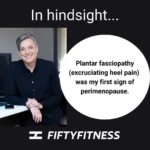
My searing heel pain nightmare
In hindsight, plantar fasciopathy was my first sign of perimenopause.
It presented itself in my late 40s, a few years before I started experiencing the classic signs in my early 50s.
The pain was intense, but I put up with it for a long time, like many women do.
One reason for my delay in getting help was denial, because I did not want to be told to stop running.
Also, I had no idea that heel pain could be related to perimenopause.
Get yourself to a podiatrist
Finally realising that I could no longer deal with the pain, I sought professional help and consulted a podiatrist in my local area.
A podiatrist is a health professional who specialises in diagnosis and treatment of conditions affecting the feet, ankles and lower limbs. Here is a detailed definition from the Australian Podiatry Association.
I need not have feared being advised to give up running.
My podiatrist was full bottle on the latest plantar fasciopathy research, and it turns out that complete rest or cessation of physical activity is not indicated.
I certainly had to decrease my running workload temporarily while I was having treatment, but:
I did not have to stop running at any stage
When I was able to increase my running, I did so very gradually.
There are a range of treatment options for plantar fasciopathy, and your podiatrist will work out the best approach for your unique situation.
Extracorporeal shock wave therapy
I had extracorporeal shock wave therapy as part of my management plan.
It sounds horrendous, and it was a bit painful to undergo, but this was a highly effective treatment in my case. Here is a quick video to show what’s involved.
Ongoing management
The shock wave therapy seemed like a miracle cure to me, but it’s not a set and forget situation.
I must be kind to my feet in the following ways to avoid recurrence:
- Managing my exercise to not overload my feet (this applies for my lower limb joint osteoarthritis too)
- Always wearing supportive footwear – especially for running and exercise (podiatrists can recommend footwear to suit your unique feet)
- Incorporating the exercises and stretches prescribed by the podiatrist into my routine
That excruciating heel pain and perimenopause could be related did not come up
The fact that plantar fasciopathy could present itself due to the decline in oestrogen that occurs during perimenopause did not come up during my treatment.
I only learned about this from a friend when I started talking about the condition emerging in my other foot!
The next time I was at the podiatrist I asked if this were the case, and they confirmed the correlation.
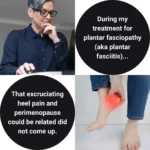
Why had they not raised this when I was having my original treatment?
It’s a known correlation, I was in the right age group, and in my opinion, this would have been helpful to know as a sufferer.
A sign of menopause on the horizon and an opportunity to consider wholistic things I could have tried in addition to the podiatry treatments.
More common than I expected
Heel pain comes up in my conversations with women in their 40s and 50s so often, it’s not funny.
It can be debilitating – causing chronic pain and impeding efforts to exercise.
I’m on a mission to raise awareness that searing heel pain could be a sign of perimenopause.
Not many women I speak to realise this – I certainly didn’t.
It may be that the onset of plantar fasciopathy occurs prior to the classic perimenopause symptoms, as in my case, or that it is simply not researched or discussed because it’s a women’s health issue.
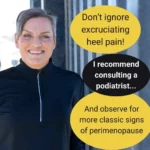
Don’t normalise your pain and suffering
If you are suffering with heel (or any) pain, do not normalise it in your mind.
There are options available to treat plantar fasciopathy – I recommend seeing a podiatrist.
It’s also a signal to look out for other perimenopause symptoms and think ahead to how you want to manage them.
It’s also important to find ways to stay active because exercise is critical at this time of your life.
This will be the topic of the next article in my ‘Exercise and Perimenopause’ series.
Learn more about exercising safely through all stages of your female life
Plantar fasciopathy is one of various things that can impede our efforts to exercise.
EVEolution™ reinforces the critical need for us to exercise and guides us in how to do it safely through all stages of our female lives.
This is knowledge for everybody, not just fitness professionals!

What is EVEolutionTM?
EVEolution™ is an online course that educates and empowers you to exercise safely through all stages of your female life.
It’s information that’s missing from your fitness trainer’s education that every trainer and woman needs to know about.
It provides the learning directly to you, so you know what to ask your trainer.
It’s a gateway to awkward but necessary conversations – we need to talk about this stuff!
Learn more and buy your own EVEolutionTM course
As an EVEolutionTM partner, I can make this brilliant course available to you.
Simply follow the link to the EVEolution page on my website to learn more and buy your own EVEolutionTM course.
Keep in touch
Please reach out to me if anything in this article resonates with you.
You can email me at kate@fiftyfitness.com.au or connect via social media.
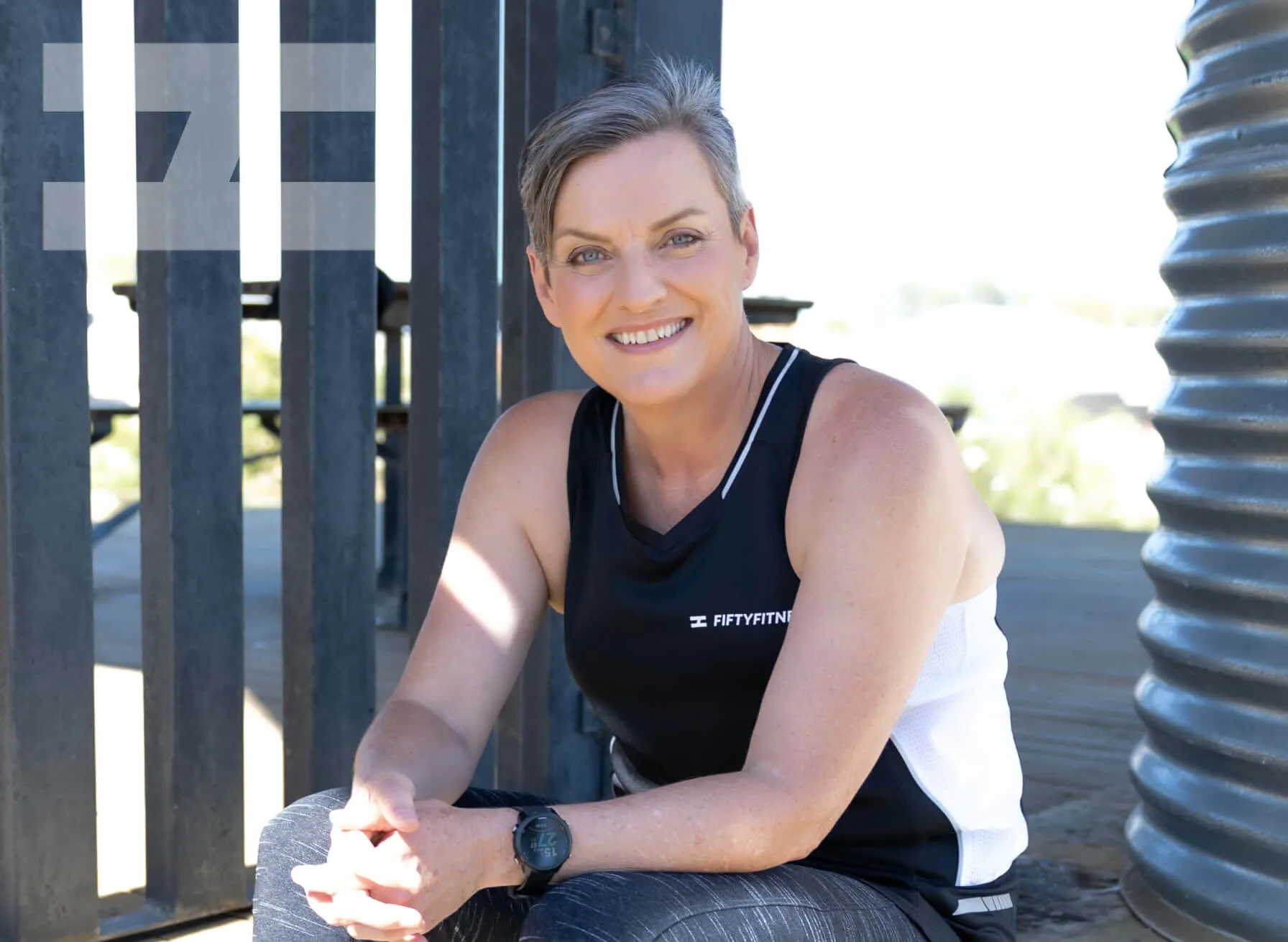
Subscribe now
Blog Subscription Form
A blog subscription form, used for the blog page and posts.
"*" indicates required fields